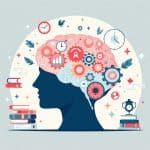You ever wonder why learning new things sometimes feels like an uphill battle, and at other times, it’s smooth as butter? If you’ve embarked on the journey of mastering a new language, you might be surprised to know that your body’s chemistry—specifically hormone regulation—plays a starring role. Sit tight, because this little deep dive could be the game-changer you didn’t know you needed.
Why Hormone Regulation Matters in Language Learning
Okay, picture this: trying to memorize verb conjugations in French, only to find that those irregular verbs just aren’t sticking. It’s not you, it’s your brain—a complex symphony of hormones determining what gets processed and retained. Sounds a bit technobabble-y, right? Trust me, it’s simpler than it sounds.
**Hormone regulation** directly impacts our cognitive functions. Imagine these hormones—like cortisol and dopamine—as your overenthusiastic cheerleaders. They either boost your learning capabilities or make you feel like you’re dragging through molasses. When balanced, they clear your path and light up those neuron pathways as if cab drivers aggressively hovering over a bustling street.
The Magic of Cortisol: Not Just the Stress Hormone
Cortisol gets a bad rap because it’s often labelled as the “stress hormone,” but it’s not all doom and gloom. In manageable doses, it amps up your focus. So, before you curse that exam anxiety, remember: a smidgen of cortisol can be your silver bullet in memory retention. Basically, it’s that kick in the pants that helps your brain hone in on those pesky language rules.
Balancing Act: Cortisol Levels

But here’s the thing, too much cortisol reverses all those good intentions. Overexposure can bog down language processing. The trick? Manage stress by integrating activities like meditation or yoga into your routine. Even a 10-minute daily routine can stabilize those cortisol levels.
Dopamine: Your Favorite Neurochemical Party
Ah, dopamine—your brain’s way of saying, “You did well, here’s a pat on the back!” Every small victory in your language learning journey, like finally remembering the word for “umbrella” without checking the dictionary, triggers a little dopamine release. Feels fab, doesn’t it?
Hack Your Dopamine Levels
Here’s how to use dopamine to your advantage:
- Reward System: Break your learning sessions down into manageable chunks and celebrate your milestones. It doesn’t have to be a monumental achievement; even brushing up on ten new vocabulary words counts.
- Gamify Learning: Use apps or study methods that introduce gamified strategies. This keeps the dopamine flow steady and encourages repeated interactions with the material.
The Esteemed Role of Learning Wellness
Let’s not ignore another piece of the pie— **learning wellness**. This concept is like the cousin to your fundamental health principles but focuses more on how your mental and physical state influences learning.
Steps to Foster Learning Wellness:

- Hydration: Ever tried to learn when you’re parched? It’s like trying to run a watermill with a trickle of water. Aim for at least eight glasses a day to keep cognitive functions zipping along.
- Nutrition: Your diet can ramp up or derail your language pursuit. Nuts, fish, and leafy greens are your on-call superheroes—packed with omega-3 fatty acids and vitamins to fuel your brain’s learning powerhouse.
- Sleep: Skimming on quality sleep? You’re short-changing your potential by not allowing your brain to process and store learning efficiently.
- Physical Activity: Fit in regular exercise, because pumping up your heart rate shifts oxygen and nutrients to the brain quicker, speeding up memory and learning functions.
Strategies for Integrating Language Learning Health
Now, let’s pull this together with some actionable strategies. You’ll need more than just desire and persistence. Successfully intertwining language learning with your natural rhythms boosts efficacy.
Three-Step Method to Harmonize Your Learning Process:
- Step 1: Set Clear Goals
- Rather than vague aspirations like “get better at Spanish,” set specific targets, such as “learn 50 conversational phrases.”
- Step 2: Schedule Like a Pro!
- Take ownership of your routine, allocating specific times of the day as your language learning hour—akin to booking a gym slot but for your brain. Early mornings or just before bed can link nicely with lower cortisol levels.
- Step 3: Mix Up the Mode
- Incorporate varied learning mediums. Podcasts one day, flashcards the next. Keeping your brain engaged with dynamic resources trickles harvesting engagement effectively—think of it as changing gears on a bike ride to keep the path thrilling.
Antidotes for Common Pitfalls

Circling back—as promethean as it sounds—the intricate link between your body’s chemistry and language learning success isn’t just another to-do on your list. But here’s what to keep tabs on to avoid common traps:
- Avoid All-Nighters: This stunt tanks your memory consolidation process.
- Mix in Human Interaction: App-based face-to-faces pump up dopamine significantly more compared to solitary study marathons.
Key Takeaways
Harnessing the potential of hormone regulation and learning wellness to bolster language acquisition can reset your learning path. Realizing and acting on these helped tweaks can transform your novel undertaking into a triumph.
Remember, effective skill acquisition in languages isn’t mystically reserved for the ‘gifted’. Instead, it’s a wonderfully human dance with your biology. So why not partner with your body’s natural rhythm and get those language-skills wheels turning smoothly?
Go ahead, give this a try with your new clarity, and who knows—you might find your journey becoming not just a destination goal but a fulfilling ride.
Frequently Asked Questions
What causes a hormonal imbalance?
A hormonal imbalance can be caused by natural changes or stages in your life, including puberty, pregnancy, perimenopause, and menopause. It can also be due to medical conditions such as tumors, adenomas, or damage to endocrine glands, as well as autoimmune diseases that attack hormone-producing glands[3][5].
How does hormone replacement therapy (HRT) work?
Hormone replacement therapy works by topping up or replacing missing hormones. During perimenopause and menopause, levels of oestradiol, progesterone, and sometimes testosterone decline. HRT involves prescribing these hormones to improve symptoms and future health, often in the form of patches, gels, sprays, or pills[1][3].
What are the common symptoms of a hormonal imbalance?
Common symptoms include irritability and fatigue, mood swings and depression, skin dryness and loss of elasticity, water retention and weight gain, osteoporosis and joint pain, reduced interest in sex, insomnia, and memory issues. These symptoms can vary depending on which hormones are imbalanced[3][5].
What are the different types of hormone replacement therapy?
Hormone therapy includes systemic hormone therapy (in pill form, patches, rings, gels, creams, or sprays), low-dose vaginal products (for vaginal and urinary symptoms), and bio-identical hormone replacement (which is structurally identical to human hormones and may have fewer side effects)[1][3].
References




